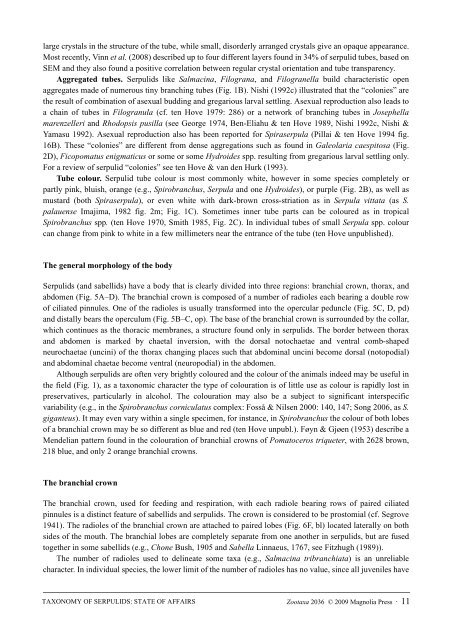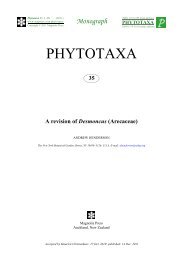Zootaxa, Taxonomy of Serpulidae (Annelida ... - Magnolia Press
Zootaxa, Taxonomy of Serpulidae (Annelida ... - Magnolia Press
Zootaxa, Taxonomy of Serpulidae (Annelida ... - Magnolia Press
You also want an ePaper? Increase the reach of your titles
YUMPU automatically turns print PDFs into web optimized ePapers that Google loves.
large crystals in the structure <strong>of</strong> the tube, while small, disorderly arranged crystals give an opaque appearance.<br />
Most recently, Vinn et al. (2008) described up to four different layers found in 34% <strong>of</strong> serpulid tubes, based on<br />
SEM and they also found a positive correlation between regular crystal orientation and tube transparency.<br />
Aggregated tubes. Serpulids like Salmacina, Filograna, and Filogranella build characteristic open<br />
aggregates made <strong>of</strong> numerous tiny branching tubes (Fig. 1B). Nishi (1992c) illustrated that the “colonies” are<br />
the result <strong>of</strong> combination <strong>of</strong> asexual budding and gregarious larval settling. Asexual reproduction also leads to<br />
a chain <strong>of</strong> tubes in Filogranula (cf. ten Hove 1979: 286) or a network <strong>of</strong> branching tubes in Josephella<br />
marenzelleri and Rhodopsis pusilla (see George 1974, Ben-Eliahu & ten Hove 1989, Nishi 1992c, Nishi &<br />
Yamasu 1992). Asexual reproduction also has been reported for Spiraserpula (Pillai & ten Hove 1994 fig.<br />
16B). These “colonies” are different from dense aggregations such as found in Galeolaria caespitosa (Fig.<br />
2D), Ficopomatus enigmaticus or some or some Hydroides spp. resulting from gregarious larval settling only.<br />
For a review <strong>of</strong> serpulid “colonies” see ten Hove & van den Hurk (1993).<br />
Tube colour. Serpulid tube colour is most commonly white, however in some species completely or<br />
partly pink, bluish, orange (e.g., Spirobranchus, Serpula and one Hydroides), or purple (Fig. 2B), as well as<br />
mustard (both Spiraserpula), or even white with dark-brown cross-striation as in Serpula vittata (as S.<br />
palauense Imajima, 1982 fig. 2m; Fig. 1C). Sometimes inner tube parts can be coloured as in tropical<br />
Spirobranchus spp. (ten Hove 1970, Smith 1985, Fig. 2C). In individual tubes <strong>of</strong> small Serpula spp. colour<br />
can change from pink to white in a few millimeters near the entrance <strong>of</strong> the tube (ten Hove unpublished).<br />
The general morphology <strong>of</strong> the body<br />
Serpulids (and sabellids) have a body that is clearly divided into three regions: branchial crown, thorax, and<br />
abdomen (Fig. 5A–D). The branchial crown is composed <strong>of</strong> a number <strong>of</strong> radioles each bearing a double row<br />
<strong>of</strong> ciliated pinnules. One <strong>of</strong> the radioles is usually transformed into the opercular peduncle (Fig. 5C, D, pd)<br />
and distally bears the operculum (Fig. 5B–C, op). The base <strong>of</strong> the branchial crown is surrounded by the collar,<br />
which continues as the thoracic membranes, a structure found only in serpulids. The border between thorax<br />
and abdomen is marked by chaetal inversion, with the dorsal notochaetae and ventral comb-shaped<br />
neurochaetae (uncini) <strong>of</strong> the thorax changing places such that abdominal uncini become dorsal (notopodial)<br />
and abdominal chaetae become ventral (neuropodial) in the abdomen.<br />
Although serpulids are <strong>of</strong>ten very brightly coloured and the colour <strong>of</strong> the animals indeed may be useful in<br />
the field (Fig. 1), as a taxonomic character the type <strong>of</strong> colouration is <strong>of</strong> little use as colour is rapidly lost in<br />
preservatives, particularly in alcohol. The colouration may also be a subject to significant interspecific<br />
variability (e.g., in the Spirobranchus corniculatus complex: Fosså & Nilsen 2000: 140, 147; Song 2006, as S.<br />
giganteus). It may even vary within a single specimen, for instance, in Spirobranchus the colour <strong>of</strong> both lobes<br />
<strong>of</strong> a branchial crown may be so different as blue and red (ten Hove unpubl.). Føyn & Gjøen (1953) describe a<br />
Mendelian pattern found in the colouration <strong>of</strong> branchial crowns <strong>of</strong> Pomatoceros triqueter, with 2628 brown,<br />
218 blue, and only 2 orange branchial crowns.<br />
The branchial crown<br />
The branchial crown, used for feeding and respiration, with each radiole bearing rows <strong>of</strong> paired ciliated<br />
pinnules is a distinct feature <strong>of</strong> sabellids and serpulids. The crown is considered to be prostomial (cf. Segrove<br />
1941). The radioles <strong>of</strong> the branchial crown are attached to paired lobes (Fig. 6F, bl) located laterally on both<br />
sides <strong>of</strong> the mouth. The branchial lobes are completely separate from one another in serpulids, but are fused<br />
together in some sabellids (e.g., Chone Bush, 1905 and Sabella Linnaeus, 1767, see Fitzhugh (1989)).<br />
The number <strong>of</strong> radioles used to delineate some taxa (e.g., Salmacina tribranchiata) is an unreliable<br />
character. In individual species, the lower limit <strong>of</strong> the number <strong>of</strong> radioles has no value, since all juveniles have<br />
TAXONOMY OF SERPULIDS: STATE OF AFFAIRS<br />
<strong>Zootaxa</strong> 2036 © 2009 <strong>Magnolia</strong> <strong>Press</strong> · 11
















